
Wine Culture and Information since 2002 - Volume 22
 Wine Culture and Information since 2002 - Volume 22 |
|
Issue 66, September 2008 |
Contents |
|
|
Wine and Beer: the Glass Challenge |
|
Bacchus versus Ceres. We did not travel back in time and imagined a hypothetical conflict between these two gods of ancient Rome, we are in the year 2008 and the names of these two gods are still dear to the lovers of wine and beer. Ceres, Roman god of fertility and of Mother Earth, is believed to have taught mortal humans the cultivations of fields and, in particular, the production of beer, one of the most ancient beverages made by men. In the last months it seems Ceres is evidently challenging Bacchus, the god of wine in ancient Rome, of vine harvesting and his cult is known as bacchanalia festival. In Italy wine and beer are in fact challenging one each other in order to conquer the highest step of the podium in the preferences of consumers. A fact that, in a country like Italy, which has a millenary culture on the consumption and tradition of wine, represents a striking news. Right in Italy, where the throne has always been occupied by wine, beer is more and more conquering the preferences of consumers, as to almost reach the consumption of the beverage of Bacchus. Maybe in Italy has come a historical moment, in which the traditional wine will progressively give its place to beer? It is undeniable beer producers and the associations connected to this beverage have done an excellent job in promotion and revaluation, without offense to anyone, by following the example of what was done for the success of wine. In restaurants, a place where wine has always been the undisputed mate of food, together with wine and spirit lists, it is now becoming more and more common the presence of beer list, not only draught beer, but also bottled beer. Typical companion of pizza in the choices of consumers, today in Italy beer is progressively becoming a companion for food as well. Wine continues to stand comparison with beer, but it is undeniable in the last months the distance between the two beverages has evidently become shorter. Maybe it is a temporary fashion, one of those many fashions which are destined to disappear in a short time, one of those which also happened for wine in the last years? Or, could it be consumers are looking for something else, tired of the “same old wine”, too much masked in its role of beverage for the élite, destined to few experts and which is making consumers feel uneasy and therefore looking for lesser formality? Without belittling beer, a beverage of noble origins and having a history even longer than wine, it is however undeniable the beverage of Ceres is less formal than the beverage of Bacchus, or at least consumers, although appreciating it, do not see any formality in beer or the ceremoniality that is usually seen in wine. Or, simply, wine does not catch the attention of consumers anymore and they got tired of it and of its fashions? Indeed, there are many who associate this receding in the consumption of wine with an Italian law concerning the assumption of alcohol and, in particular, the fear of incurring in serious penalties and fines in case, while driving a vehicle, one's blood alcohol content would be higher than what has been set by law. According to this point of view, beer certainly has an advantage over wine. With its lower volume in alcohol - wine contains an average of 13%, whereas beer has just 5% - the beverage of Ceres seems to promise less troubles in case one is being stopped by the police. We sincerely hope this is not corresponding to the truth: it is sad to think consumers choose a beverage - wine or beer, it makes no difference - only because for this reason and not because of a conscious choice. A behavior like that will certainly make happy the ones who work in commercial strategies, but not the ones who understand the culture expressed by these two beverages. We believe it is offensive in any case, both to the tradition and culture of these two millenary beverages, as well as for the ones who make this silly choice and which can be sadly defined as boozer, as to not exaggerate in the use of other less kind terms. And in case the result of a law is to frighten or to repress instead of making people understand and to favor a conscious culture for the consumption of alcohol, therefore it is a law which needs improvements and which brings negative consequences only, at least in the culture of people. Human beings, as it is commonly known, in case something is forbidden, as soon as they can, they will break that rule adopted only to repress and which does not create anything. Prohibitionism has probably taught something, in this sense. Whether beer is getting more and more the favor of consumers is evident, and not only at the restaurant. For certain aspects, it can be seen in beer what has been seen in wine some years ago. For example, it is enough a quick visit to any supermarket and if once there were large sectors dedicated to wine, today are also seen large sectors dedicated to beer as well, with a broad range of types, producers, from cans to bottles: anyone can find the beer he or she likes the most. And if once in the tables of pizzeria restaurants were glasses of draught beer, today are frequently seen bottles instead. The same can be seen in restaurants, in that place where bottled beer was considered as a pretty bizarre request and the best you could get, in the best cases, was draught beer, most of the times of disputable quality. Let's make things clear: these are not considerations caused by envy or the fear of seeing the beverage of Bacchus to fade, something - frankly speaking - which seems to be pretty improbable. Beer, just like wine, is a noble and ancient beverage, rich in culture and which certainly deserves attention. In case it is about to exalt the cultural aspect of a beverage, and not its consumistic aspect, one should be happy for this, indeed, one is also well disposed to favor it. There are many who believe wine, as opposed to beer, has a higher charm and a higher nobility, and for this reason, beer will never reach the prestige of wine. It is however undeniable that when a beer is of good quality, in particular certain and praiseworthy results obtained by some artisanal breweries - so distant from the industrial reality - also a good glass of the beverage of Ceres can give good emotions. And certainly Bacchus, on the strength of his sturdy fame of glorious fast liver, will certainly be pleased with a smile, while winking his eye at the colleague Ceres.
|
||||
Comparing Primitivo di ManduriaAmong the first wines of Apulia to have caught the attention of wine lovers in the world, Primitivo di Manduria is produced in the dry and sweet styles |
|
Despite its name could make anyone think differently, Primitivo has nothing in common with prehistory. Primitivo is among the most famous grapes of Apulia and it can be found in all the region, where it is generally used alone as well as together with other Apulian autochthonous or international grapes. The most famous representation of Primitivo certainly is the one of Manduria area, in the province of Taranto. The origin of this grape has been a mystery for a long time. Although now Primitivo is considered an autochthonous grape of Apulia, this grape shares its origin with another famous grape, the only one the viticulturists of the United States of America consider to be autochthonous in their country: Zinfandel. Researches done by geneticist Carole Meredith of the renowned University of California Davis, have finally allowed to reveal the history and the origins of this grape. The first result was the discovery of the fact Zinfandel is similar to Primitivo. This fact was used by wine producers in Apulia who started exporting their Primitivo wines in the United States, even writing in the label the name Zinfandel. Researches allowed the discovery of the fact Plavac Mali, a grape from Dalmatia, in Croatia, was genetically similar to Zinfandel, and therefore to Primitivo, and the grapes shared the same origin. Further researches allowed the identification of a Dalmatian grape having genetic characteristic very similar to Zinfandel: Dobričić. Finally the researches on the vineyards of the area allowed the identification of a grape genetically equal to Zinfandel and therefore to Primitivo. it was the rare red berried grape - now almost extinct and almost forgotten in Croatia - discovered in the city of Kaštela and known as Crljenak Kaštelanski. It is not however clear how this grape reached the United States of America, whereas it is very likely it was introduced in Apulia at the end of the seventeenth century by some Slav people migrated to the region.
|
|
The vocation of the Manduria area to viticulture was already known and appreciated at the times of ancient Romans. Pliny the Elder defined Manduria as viticulosae, that is “full of vineyards”, although at those times it was not Primitivo. Despite its name could make anyone think at very ancient origins, at prehistorical times, indeed Primitivo takes it name from the fact it tends to ripe in advance than other varieties. Thanks to this quality, the grape was known in past times with the name of primativus or primaticcio, and lately known with the current name of Primitivo. Manduria is the most famous and representative area for Primitivo and has been one of the first wine areas of Apulia to be known in the world. Wines produced in this area belong to the category of Denominazione d'Origine Controllata (Denomination of Controlled Origin, DOC). In Manduria, Primitivo is the only grape allowed for making the wines of the area and it is produced in the dry style - the most famous one - as well as natural sweet (dolce naturale), fortified dry liquoroso secco) and natural fortified sweet liquoroso dolce naturale).
According to the production disciplinary, Primitivo di Manduria is produced with 100% of the homonymous grape, and despite there is no explicit mention to the aging method, producers usually prefer to do this practice in cask or barrique, as in the case of the wines of our comparative tasting. The first wine is Accademia dei Racemi's Primitivo di Manduria Zinfandel Sinfarosa, aged in part in cask and in part in steel tanks. The second wine of the tasting is Vinicola Savese's Primitivo di Manduria Tradizione del Nonno, aged in part in barrique. The third wine of our tasting is Soloperto's Primitivo di Manduria Patriarca, aged for 9 months in barrique and for 2 years in cask. The three wines will be served at the temperature of 18°C (65°F) - in order to exalt the typical qualities of Primitivo and of its aromas - and will be served, as usual, in three ISO tasting glasses.
|
||||||||
|
Primitivo is a grape capable of producing wines of full body, characterized by very intense colors and with pretty low transparencies, sometimes also impenetrable to light. Thanks to its content in coloring substances, Primitivo enriches its wines with pretty deep and intense hues, something which is also accentuated by the aging in cask - the most common choice for this grape - with the result of obtaining very low transparencies. The richness in polyphenols allows wines produced with Primitivo to stand to long period of aging in bottle, a period during which the color develops. During its youth, Primitivo shows an intense and deep ruby red color, with ruby red or purple red nuances. After some years can be noticed an evident change, where the color turns into garnet red and the nuance gets a brick orange hue, a color which is also noticed at the top of its evolution. We will begin the phase of appearance analysis from Accademia dei Racemi's Primitivo di Manduria Zinfandel Sinfarosa. By holding the glass tilted over a white surface, it will be observed the base of the glass in order to assess its color. It will be noticed a strong and intense ruby red color and a pretty low transparency. Also the nuance will show the same color, which can be observed at edge of the liquid mass, towards the opening of the glass. Let's now pass to the observation of the second wine of our comparative tasting: Vinicola Savese's Primitivo di Manduria Tradizione del Nonno. Also in this case the color is characterized by an intense ruby red color and a pretty low transparency, whereas nuance begins to show a garnet red color. The color of the third wine - Soloperto's Primitivo di Manduria Patriarca - is not so different from the second wine. Also in this case it will be observed an intense ruby red color and a pretty low transparency, with red garnet nuances.
|
|
Primitivo di Manduria, thanks to its good possibilities of evolution, develops with time an interesting olfactory profile, where the typical smells of fruit and flowers join pretty complex aromatic sensations. During its youth, Primitivo di Manduria expresses its full character of fruits and flowers. Black cherry, plum and blackberry are the most typical fruit qualities of Primitivo di Manduria, whereas violet - also dried - is the most frequent flower aroma. Fruit sensations of Primitivo di Manduria, after some years, turn into sensations of jams, a quality which can also be frequently found in young wines. With time in Primitivo di Manduria can be perceived complex aromatic qualities, also given by the aging in cask or barrique. With time can also be perceived aromas of cocoa, chocolate, tobacco, licorice and carob, as well as cinnamon, cinchona and black pepper, including balsamic sensations of menthol. We will start the evaluation of olfactory qualities of the wines of our comparative tasting from Accademia dei Racemi's Primitivo di Manduria Zinfandel Sinfarosa. By holding the glass in vertical position and without swirling, we will proceed with the first smell in order to evaluate opening aromas, that is the “lighter” olfactory sensations which can easily volatilize with a small quantity of oxygen. To the nose will be perceived clean and intense aromas of black cherry, plum and blackberry, three aromatic qualities among the most representative ones in Primitivo. Let's now proceed with swirling the glass, in order to favor the development of aromas thanks to the higher oxygenation and that will favor the perception of “higher” aromatic qualities which will complete the olfactory profile of this Primitivo di Manduria. From the glass will emerge aromas of violet and blueberry, to which will follow complex aromas of vanilla, licorice, cocoa, tobacco and hints of black pepper, including the balsamic touch of menthol. Let's now pass to the olfactory evaluation of the second wine of our comparative tasting: Vinicola Savese's Primitivo di Manduria Tradizione del Nonno. The opening of this wine will give the nose intense and clean aromas of plum, blackberry and black cherry, identifying qualities of Primitivo. After having swirled the glass, we will proceed with the second smell in order to complete the olfactory profile of this wine. From the glass will be appreciated aromas of dried violet, tamarind, carob, tobacco, vanilla, licorice, mace and the pleasing balsamic touch of menthol. The opening of the third wine - Soloperto's Primitivo di Manduria Patriarca - offers to the nose ripe fruit aromas of plum jam, blackberry jam and black cherry jam. The second smell, done after having swirled the glass, will complete the olfactory profile of the third wine with aromas of carob, blueberry jam, licorice, vanilla and hints of star anise as well as the pleasing balsamic touch of menthol.
|
||||
|
Primitivo di Manduria, thanks to the qualities of the grape with which it is produced, is a wine generally characterized by a good body, most of the times robust and - also thanks to the sun of Apulia - with pretty high volumes of alcohol and which can sometimes be greater than 15%. Primitivo is a grape with a good content in polyphenolic substances, a quality that, besides giving body to the wine, also gives a certain astringency. The aging in wood of Primitivo, both in cask or barrique, allows the wines produced with this grape to smooth their harshness, while increasing roundness, a quality which is also increased by alcohol. Because of the high content of sugar found in this grape, sometimes in Primitivo di Manduria can also be found non fermented residual sugar and which gives the wine both a slight sweetness as well as an increased roundness. The first wine of which we will evaluate taste is Accademia dei Racemi's Primitivo di Manduria Zinfandel Sinfarosa. The attack of this Primitivo has an appreciable astringency of tannins and a good body, qualities which are well balanced by alcohol and roundness. Let's now pass to the evaluation of the second wine, Vinicola Savese's Primitivo di Manduria Tradizione del Nonno. The attack of this Primitivo is definitely tannic with a full body, sensations which are contrasted by a strong roundness and a higher alcoholic sensation, in this wine being of 16%. It should also be noticed the difference on the impact of wood compared to the previous wine. We will now proceed with the third wine of the comparative tasting, Soloperto's Primitivo di Manduria Patriarca, offering to the mouth a pleasing smooth attack and tannins, despite they are well perceivable, are characterized by a good ripeness while giving the wine a round character. The body of this Primitivo is evidently robust and it should be noticed, as opposed to the previous wines, the flavors of fruits resembling jams.
|
|
The structure and alcoholic volume probably are the two most evident qualities of Primitivo di Manduria at tasting, qualities which are pretty evident also in the wines of our comparative tasting. The finish of Accademia dei Racemi's Primitivo di Manduria Zinfandel Sinfarosa is persistent with flavors of black cherry, blackberry and plum, the three most typical fruity qualities of Primitivo. The finish of the second wine - Vinicola Savese's Primitivo di Manduria Tradizione del Nonno - is persistent with flavors of black cherry, plum and blackberry, just like the previous wine. Also the finish of the third wine, Soloperto's Primitivo di Manduria Patriarca, is persistent, however in this case the flavors perceived in the mouth are riper and resembling blackberry jam, plum jam and black cherry jam. Besides the evident body which can be perceived in the mouth after having swallowed the sample, it should also be noticed the pleasing sensation of roundness, in particular in the last two wines.
|
Wines of the Month |
|
|
|
Score legend Prices are to be considered as indicative. Prices may vary according to the country or the shop where wines are bought |
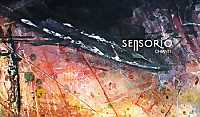
|
|
Chianti Sensorio 2005 |
|
| Tenuta di Pomine (Tuscany, Italy) | |
| Grapes: Sangiovese, Colorino | |
| Price: € 9.70 | Score: |
| Chianti Sensorio shows an intense ruby red color and nuances of garnet red, little transparency. The nose denotes intense, clean, pleasing and refined aromas that start with hints of black cherry, plum and raspberry followed by aromas of blackberry, violet, vanilla, blueberry, cyclamen and carob. The mouth has good correspondence to the nose, a tannic attack and pleasing crispness, however balanced by alcohol, good body, intense flavors. The finish is persistent with flavors of black cherry, plum and blackberry. Chianti Sensorio ages for 3 months in barrique. | |
| Food Match: Roasted meat, Broiled meat and barbecue, Stewed meat, Hard cheese | |

|
|
Ledo 2005 |
|
| Tenuta di Pomine (Tuscany, Italy) | |
| Grapes: Sangiovese, Merlot | |
| Price: € 12.60 | Score: |
| Ledo shows an intense ruby red color and nuances of ruby red, little transparency. The nose denotes intense, clean, pleasing and refined aromas that start with hints of black cherry, black currant and plum followed by aromas of violet, vanilla, blueberry, cocoa, eucalyptus, cinnamon and mace. The mouth has good correspondence to the nose, a tannic attack and however balanced by alcohol, good body, intense flavors, pleasing roundness. The finish is persistent with flavors of black cherry, black currant and plum. Ledo ages for 6 months in barrique. | |
| Food Match: Roasted meat, Braised and stewed meat, Hard cheese | |
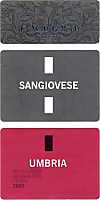
|
|
Sangiovese 2006 |
|
| Flavio Busti (Umbria, Italy) | |
| Grapes: Sangiovese | |
| Price: € 6.00 | Score: |
| This wine shows a brilliant ruby red color and nuances of ruby red, moderate transparency. The nose denotes intense, clean and pleasing aromas which start with hints of plum, black cherry and violet followed by aromas of blackberry, blueberry and raspberry. The mouth has good correspondence to the nose, a slightly tannic attack and however balanced by alcohol, good body, intense flavors. The finish is persistent with flavors of black cherry and plum. This Sangiovese ages in steel tanks. | |
| Food Match: Pasta with meat, Sauteed meat with mushrooms, Roasted white meat | |
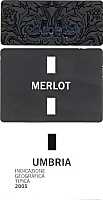
|
|
Merlot 2005 |
|
| Flavio Busti (Umbria, Italy) | |
| Grapes: Sangiovese | |
| Price: € 8.50 | Score: |
| This Merlot shows an intense ruby red color and nuances of garnet red, little transparency. The nose reveals intense, clean, pleasing and refined aromas that start with hints of black cherry, plum and black currant followed by aromas of violet, blueberry, vanilla, chocolate and menthol. The mouth has good correspondence to the nose, a slightly tannic attack and pleasing roundness, however balanced by alcohol, good body, intense flavors. The finish is persistent with flavors of black cherry, plum and blueberry. This wine ages in barrique. | |
| Food Match: Broiled meat and barbecue, Roasted meat, Stewed meat, Hard cheese | |
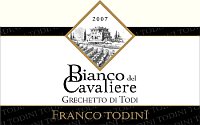
|
|
Colli Martani Grechetto di Todi Bianco del Cavaliere 2007 |
|
| Franco Todini (Umbria, Italy) | |
| Grapes: Grechetto (85%), Other Grapes (15%) | |
| Price: € 9.00 | Score: |
| This wine shows a brilliant straw yellow color and nuances of greenish yellow, very transparent. The nose denotes intense, clean, pleasing and refined aromas which start with hints of pear, peach and apple followed by aromas of hawthorn, hazelnut, apple and pineapple. The mouth has good correspondence to the nose, a crisp attack and however balanced by alcohol, good body, intense flavors. The finish is persistent with flavors of apple, pear and peach. Colli Martani Grechetto di Todi Bianco del Cavaliere ages in steel tanks. | |
| Food Match: Vegetable and fish appetizers, Pasta and risotto with crustaceans, Sauteed white meat | |

|
|
Nero della Cervara 2004 |
|
| Franco Todini (Umbria, Italy) | |
| Grapes: Merlot (50%), Cabernet Sauvignon (50%) | |
| Price: € 25.00 | Score: |
| Nero della Cervara shows an intense ruby red color and nuances of garnet red, little transparency. The nose reveals intense, clean, pleasing, refined and elegant aromas that start with hints of plum, black cherry and black currant followed by aromas of blueberry, violet, vanilla, tobacco, black pepper, chocolate, cinnamon, mace and eucalyptus. The mouth has good correspondence to the nose, a tannic attack and pleasing roundness, however balanced by alcohol, full body, intense flavors, agreeable. The finish is persistent with flavors of plum, black currant and black cherry. A well made wine. Nero della Cervara ages in barrique for 15 months followed by 6 months of aging in bottle. | |
| Food Match: Game, Roasted meat, Braised and stewed meat, Hard cheese | |
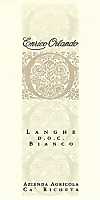
|
|
Langhe Bianco 2006 |
|
| Ca' Richeta (Piedmont, Italy) | |
| Grapes: Chardonnay (50%), Sauvignon Blanc (30%), Other Grapes (20%) | |
| Price: € 12.00 | Score: |
| This wine shows an intense straw yellow color and nuances of greenish yellow, very transparent. The nose reveals intense, clean, pleasing and refined aromas which start with hints of banana, peach and toasted wood followed by aromas of pineapple, apple, hazelnut, grapefruit, vanilla, plum and lavender. The mouth has good correspondence to the nose, a crisp and round attack, however balanced by alcohol, good body, intense flavors. The finish is persistent with flavors of banana, peach and hazelnut. Langhe Bianco ages for 12 months in barrique followed by 6 months of aging in bottle. | |
| Food Match: Stuffed pasta, Roasted white meat, Roasted fish, Mushroom soups | |
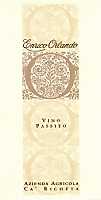
|
|
Vino Passito 2004 |
|
| Ca' Richeta (Piedmont, Italy) | |
| Grapes: Moscato Bianco (80%), Sauvignon Blanc (10%), Other Grapes (10%) | |
| Price: € 22.00 - 375ml | Score: |
| This wine shows a brilliant amber yellow color and nuances of amber yellow, transparent. The nose reveals intense, clean, pleasing, refined and elegant aromas which start with hints of raisin, dried fig and almond followed by aromas of peach jam, quince jam, candied fruits, vanilla, honey, citrus fruit peel, date, lavender and caramel. The mouth has good correspondence to the nose, a sweet and round attack, however balanced by alcohol, good body, intense flavors, pleasing crispness. The finish is persistent with flavors of raisin, dried fig and almond. A well made wine. Vino Passito ages for 24 months in barrique followed by 6 months of aging in bottle. | |
| Food Match: Hard and piquant cheese, Dried fruit desserts | |
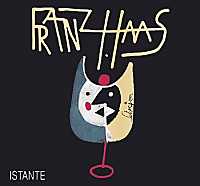
|
|
Istante 2004 |
|
| Franz Haas (Alto Adige, Italy) | |
| Grapes: Cabernet Sauvignon, Cabernet Franc, Merlot, Petit Verdot | |
| Price: € 25.20 | Score: |
| Istante shows an intense ruby red color and nuances of ruby red, little transparency. The nose reveals intense, clean, pleasing, refined and elegant aromas which start with hints of black currant, plum and black cherry followed by aromas of blueberry, violet, vanilla, bell pepper, tobacco, cocoa, cinchona, eucalyptus and mace. The mouth has good correspondence to the nose, a tannic attack and however balanced by alcohol, good body, intense flavors, pleasing roundness. The finish is persistent with flavors of black currant, plum and black cherry. A well made wine. Istante ages in barrique. | |
| Food Match: Roasted meat, Braised and stewed meat, Hard cheese | |
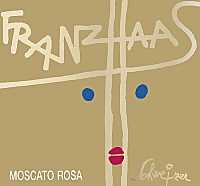
|
|
Alto Adige Moscato Rosa 2006 |
|
| Franz Haas (Alto Adige, Italy) | |
| Grapes: Pink Muscat | |
| Price: € 21.80 - 375ml | Score: |
| Alto Adige Moscato Rosa shows a brilliant ruby red color and nuances of ruby red, moderate transparency. The nose reveals intense, clean, pleasing, refined and elegant aromas that start with hints of grape, strawberry and rose followed by aromas of cherry, raspberry, carnation, violet, pink pepper, musk, geranium, cinnamon, clover and star anise. The mouth has excellent correspondence to the nose, a sweet and crisp attack, however balanced by alcohol, good body, intense flavors, pleasing roundness. The finish is very persistent with long flavors of strawberry, cherry and raspberry. A well made wine. Alto Adige Moscato Rosa ages in steel tanks and for at least 6 months in bottle. | |
| Food Match: Fruit desserts | |
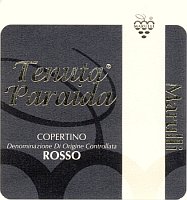
|
|
Copertino Rosso Tenuta Paraida 2005 |
|
| Marulli (Apulia, Italy) | |
| Grapes: Negroamaro (80%), Malvasia Nera (20%) | |
| Price: € 4.00 | Score: |
| Copertino Rosso Tenuta Paraida shows a brilliant ruby red color and nuances of brick red, moderate transparency. The nose denotes intense, clean and pleasing aromas which start with hints of plum, black cherry and blackberry followed by aromas of dried violet, blueberry, vanilla and carob. The mouth has good correspondence to the nose, a slightly tannic attack and pleasing roundness, however balanced by alcohol, good body, intense flavors. The finish is persistent with flavors of plum, black cherry and blackberry. Copertino Rosso Tenuta Paraida ages for about 6 months in barrique. | |
| Food Match: Roasted meat, Stewed and braised meat, Hard cheese | |
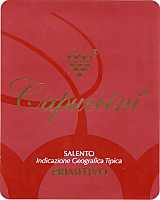
|
|
Capuccini 2005 |
|
| Marulli (Apulia, Italy) | |
| Grapes: Primitivo | |
| Price: € 4.80 | Score: |
| This wine shows an intense ruby red color and nuances of ruby red, moderate transparency. The nose reveals intense, clean and pleasing aromas that start with hints of plum, blackberry and black cherry followed by aromas of violet, vanilla, carob and tobacco. The mouth has good correspondence to the nose, a tannic attack and pleasing roundness, however balanced by alcohol, good body, intense flavors. The finish is persistent with flavors of plum, blackberry and black cherry. Capuccini ages for about 15 months in cask. | |
| Food Match: Stuffed pasta, Roasted meat, Stewed meat | |
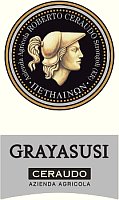
|
|
Grayasusi Etichetta Argento 2007 |
|
| Ceraudo (Calabria, Italy) | |
| Grapes: Gaglioppo | |
| Price: € 16.50 | Score: |
| Grayasusi Etichetta Argento shows a brilliant cherry pink color and nuances of cherry pink, transparent. The nose reveals intense, clean, pleasing and refined aromas which start with hints of cherry, strawberry and raspberry followed by aromas of blueberry, peach, pink pepper, vanilla, cyclamen and plum. The mouth has good correspondence to the nose, a crisp attack and pleasing roundness, however balanced by alcohol, good body, intense flavors. The finish is persistent with flavors of cherry, strawberry and raspberry. Grayasusi Etichetta Argento ages for 6 months in barrique. | |
| Food Match: Roasted white meat, Roasted fish, Stuffed pasta | |
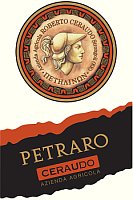
|
|
Petraro 2005 |
|
| Ceraudo (Calabria, Italy) | |
| Grapes: Gaglioppo (50%), Cabernet Sauvignon (50%) | |
| Price: € 17.00 | Score: |
| Petraro shows an intense ruby red color and nuances of garnet red, little transparency. The nose reveals intense, clean, pleasing, refined and elegant aromas which start with hints of black currant, black cherry and plum followed by aromas of blueberry, violet, vanilla, tobacco, black pepper, chocolate, cinnamon, mace and eucalyptus. The mouth has good correspondence to the nose, a tannic attack and pleasing roundness, however balanced by alcohol, good body, intense flavors, agreeable. The finish is persistent with flavors of black cherry, plum and black currant. A well made wine. Petraro ages for 18 months in barrique. | |
| Food Match: Roasted meat, Braised and stewed meat, Hard cheese | |
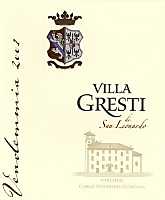
|
|
Villa Gresti 2004 |
|
| Tenuta San Leonardo (Trentino, Italy) | |
| Grapes: Merlot (90%), Carmenère (10%) | |
| Price: € 28.00 | Score: |
| Villa Gresti shows an intense ruby red color and nuances of garnet red, little transparency. The nose reveals intense, clean, pleasing, refined and elegant aromas which start with hints of black cherry, plum and black currant followed by aromas of blueberry, vanilla, tobacco, white pepper, bell pepper, mace, licorice, chocolate, cinnamon and eucalyptus. The mouth has very good correspondence to the nose, a tannic attack and however balanced by alcohol, full body, intense flavors, pleasing roundness. The finish is very persistent with long flavors of black cherry, plum and black currant. A well made wine. Villa Gresti ages in barrique for 14 months followed by at least 12 months of aging in bottle. | |
| Food Match: Game, Roasted meat, Stewed and braised meat, Hard cheese | |
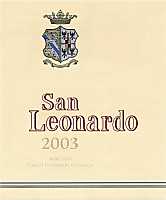
|
|
San Leonardo 2003 |
|
| Tenuta San Leonardo (Trentino, Italy) | |
| Grapes: Cabernet Sauvignon (60%), Cabernet Franc (30%), Merlot (10%) | |
| Price: € 45.00 | Score: |
| San Leonardo shows a deep ruby red color and nuances of garnet red, little transparency. The nose reveals intense, clean, pleasing, refined and elegant aromas that start with hints of black currant, black cherry and plum followed by aromas of vanilla, violet, blueberry, tobacco, licorice, mace, bell pepper, pink pepper, chocolate, clover, cinnamon and eucalyptus. The mouth has good correspondence to the nose, a tannic attack and pleasing roundness, however well balanced by alcohol, full body, intense flavors, very agreeable. The finish is very persistent with long flavors of black currant, black cherry and plum. A well made wine. San Leonardo ages for 24 months in barrique followed by 12 months of aging in bottle. | |
| Food Match: Game, Roasted meat, Stewed and braised meat, Hard cheese | |
News |
|
In this section are published news and information about events concerning the world of wine and food. Whoever is interested in publishing this kind of information can send us a mail to our address.
|
AquavitaeReview of Grappa, Distillates and Brandy |
|
|
| Distillates are rated according to DiWineTaste's evaluation method. Please see score legend in the "Wines of the Month" section. |
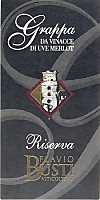
|
|
Grappa di Merlot Riserva |
|
| Flavio Busti (Umbria, Italy) | |
| (Distiller: Distilleria Nannoni) | |
| Raw matter: Pomace of Merlot | |
| Price: € 12.00 - 50cl | Score: |
| This grappa shows an intense golden yellow color, crystalline. The nose reveals intense, clean, pleasing and refined aromas of black cherry, plum, vanilla, honey, hazelnut and date, with almost imperceptible alcohol pungency. In the mouth has intense flavors, perceptible alcohol pungency which tends to dissolve rapidly, good correspondence to the nose, pleasing roundness. The finish is persistent with flavors of plum, honey and hazelnut. This grappa is distilled with steam operated discontinuous alembic still. Alcohol 42% | |
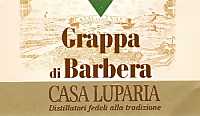
|
|
Grappa di Barbera |
|
| Casa Luparia (Piedmont, Italy) | |
| Raw matter: Pomace of Barbera | |
| Price: € 10.00 - 50cl | Score: |
| This grappa is colorless and crystalline. The nose denotes intense, clean, pleasing and refined aromas of cherry, plum, violet, hazelnut and licorice, with almost imperceptible alcohol pungency. In the mouth has intense flavors, with perceptible alcohol pungency and which tends to dissolve rapidly, good correspondence to the nose, balanced sweetness, pleasing roundness. The finish is persistent with flavors of cherry, plum and hazelnut. A grappa made with a discontinuous alembic still operating at low pressure. Alcohol 42% | |
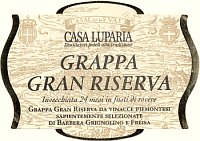
|
|
Grappa Gran Riserva |
|
| Casa Luparia (Piedmont, Italy) | |
| Raw matter: Pomace of Barbera, Grignolino, Freisa | |
| Price: € 12.50 - 50cl | Score: |
| This grappa shows a pale straw yellow color, crystalline. The nose reveals intense, clean, pleasing and refined aromas of licorice, honey, vanilla, plum, violet, hazelnut, black cherry and chocolate, with almost imperceptible alcohol pungency. In the mouth has intense flavors, with perceptible alcohol pungency and which tends to dissolve rapidly, good correspondence to the nose, balanced sweetness, pleasing smoothness. The finish is persistent with flavors of honey, hazelnut, plum and licorice. A well made grappa produced with discontinuous distillation at very low steam pressure. It ages for more than 24 months in cask. Alcohol 42% | |
Wine Parade |
|
|
| The best 15 wines according to DiWineTaste's readers. To express your best three wines send us an E-mail or fill in the form available at our WEB site. |
| Rank | Wine, Producer | |
|---|---|---|
| 1 |
| San Leonardo 2001, Tenuta San Leonardo (Italy) |
| 2 |
| Bradisismo 2003, Inama (Italy) |
| 3 |
| Wine Obsession 2001, Vignamaggio (Italy) |
| 4 |
| Chianti Classico Riserva Novecento 2000, Dievole (Italy) |
| 5 |
| Blanc des Rosis 2006, Schiopetto (Italy) |
| 6 |
| Barolo Bussia 2001, Prunotto (Italy) |
| 7 |
| Collio Bianco Col Disôre 2004, Russiz Superiore (Italy) |
| 8 |
| Sforzato di Valtellina San Domenico 2002, Triacca (Italy) |
| 9 |
| Barolo Cannubi Boschis 2001, Sandrone (Italy) |
| 10 |
| Aglianico del Vulture La Firma 2004, Cantine del Notaio (Italy) |
| 11 |
| Sangiovese di Romagna Superiore Riserva Thea 2005, Tre Monti (Italy) |
| 12 |
| Amarone della Valpolicella Classico 2000, Zenato (Italy) |
| 13 |
| Sagrantino di Montefalco Collepiano 2003, Arnaldo Caprai (Italy) |
| 14 |
| Sforzato di Valtellina Canua 2001, Conti Sertoli Salis (Italy) |
| 15 |
| Moscato d'Asti 2007, Vignaioli di S. Stefano (Italy) |
| |||||||
Privacy Policy | |||||||


| Copyright © 2002-2024 Antonello Biancalana, DiWineTaste - All rights reserved |
| All rights reserved under international copyright conventions. No part of this publication and of this WEB site may be
reproduced or utilized in any form or by any means, electronic or mechanical, without permission in writing from DiWineTaste. |